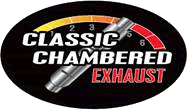Re: Why less power with sidepipes?
Here are all of the U.S. manufacturers of Corvette side pipe mufflers/inserts#:
http://www.allencorvetteexhaustsystems.com
http://www.spiralturbobaffles.com/ (I recommend these for BBC only, using Hooker sidepipes)
If you find anybody who makes a muffler that will attenuate as well as a N11 setup, or a Walker DynoMax while also presenting minimal flow restriction, then let me know.
Maybe you can invent one by using wave cancellation theory, by directing 180 degree phased waves back at the outlets. Really. Patent them.
Really. Patent them.
Short of that, I recommend that you take a good look at the Classic Chambered website. One of their offerings is by far, the best you'll be able to do with sidepipes. If you fabricate a side exhaust system using those, along with a large diameter, short crossover pipe, close to the header collectors (or manifold exits), I believe that you'll be very happy with the results.
PS: I was very instrumental in giving the manufacturer the idea of fabricating and marketing this system. Watch and listen to the video clips.
#: All of these will fit under stock 1965-67 sidepipe covers, except those with a 3 1/2" outer shell, which may require a 1/2" spacer. Wrapping those with 3" and 3 1/2" outer shells in a thermal blanket is recommended.
Here are all of the U.S. manufacturers of Corvette side pipe mufflers/inserts#:
http://www.allencorvetteexhaustsystems.com
http://www.spiralturbobaffles.com/ (I recommend these for BBC only, using Hooker sidepipes)
If you find anybody who makes a muffler that will attenuate as well as a N11 setup, or a Walker DynoMax while also presenting minimal flow restriction, then let me know.

Maybe you can invent one by using wave cancellation theory, by directing 180 degree phased waves back at the outlets.
 Really. Patent them.
Really. Patent them.Short of that, I recommend that you take a good look at the Classic Chambered website. One of their offerings is by far, the best you'll be able to do with sidepipes. If you fabricate a side exhaust system using those, along with a large diameter, short crossover pipe, close to the header collectors (or manifold exits), I believe that you'll be very happy with the results.

PS: I was very instrumental in giving the manufacturer the idea of fabricating and marketing this system. Watch and listen to the video clips.
#: All of these will fit under stock 1965-67 sidepipe covers, except those with a 3 1/2" outer shell, which may require a 1/2" spacer. Wrapping those with 3" and 3 1/2" outer shells in a thermal blanket is recommended.


Comment